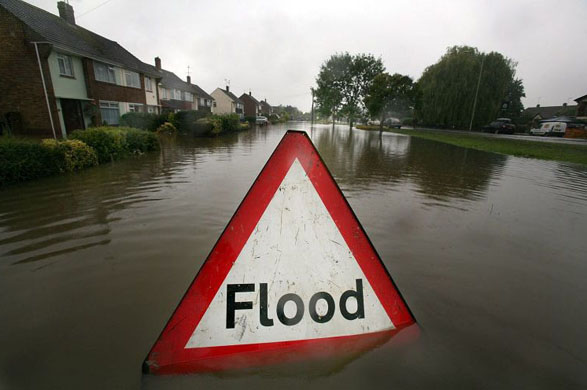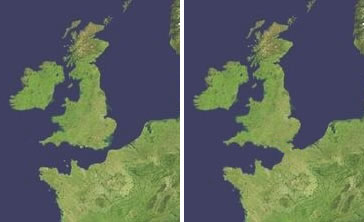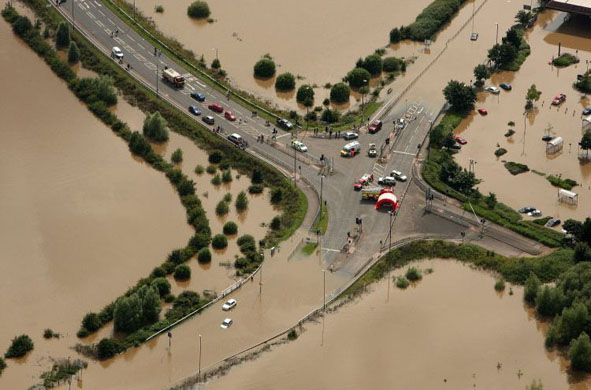 [Image: A thoughtfully signposted British flood; photo by Matt Cardy for Getty Images].
[Image: A thoughtfully signposted British flood; photo by Matt Cardy for Getty Images].I'm totally fascinated by the idea that adventure tourism firms might someday lead wreck-diving tours through the flooded ruins of London: in your expensive re-breathing gear, you'll roll backward off a boat, flashlight in hand... and the coral-specked vaults of St. Paul's are now yours to explore.
All the churches of Nicholas Hawksmoor, as seen through a diving mask. Or the Tube, full of moray eels, awaiting the truly brave.
Fantastically, that's not so unrealistic an image – because London, after all, is sinking.
Using satellite measurement, tide gauges, GPS, and a few other devices called "absolute gravimeters," a new study proves that London is moving downward into the Earth's surface in "a general pattern of subsidence of 1-2mm a year. With waters rising in the region by about 1mm a year, the combined effect is a 2-3mm a year rise in sea level with respect to the land."
- The investigation confirms geologic studies that show the Earth's crust is still responding to the loss of the heavy ice sheet which covered much of Britain more than 10,000 years ago – with southeast England, including London, slowly sinking.
To help protect against these encoaching waters, the city contains or is surrounded by a rarely noticed hydrological labyrinth: "300km of tidal defences including embankments, walls, gates and barriers."
However, "at some stage, [these will] have to be adapted or moved" – at least until "new types of defences [are] created that make better use of the natural floodplain."
I love this stuff. In fact, I'm 100% convinced that if architectural magazines really wanted to discuss what the London of tomorrow will look like, they'd have stopped talking to architects a long time ago – and they'd have flood consultants on the phone.
The future of London will be determined by hydrological engineers.
 [Image: The Tewkesbury flood of 2007, as seen from the air; photo by Daniel Berehulak for Getty Images].
[Image: The Tewkesbury flood of 2007, as seen from the air; photo by Daniel Berehulak for Getty Images].In any case, London is also jostling up and down on the Earth's surface, everyday, bobbing up and down like a buoy with the tides; these micro-movements need to be taken into account by anyone who hopes to study the effects of so-called post-glacial rebound.
- London itself will rock by 10mm, twice a day, with loading from ocean tides. The seasons also alternately load and unload the ground, making the Earth's crust "breathe" up and down over a longer period.
But if you want more stuff like that, this older post is rather heavy on British hydro-speculation.
Meanwhile, a "lost" village in Wiltshire might offer a glimpse of London's own future to come. From the BBC:
- A team of divers who set out to solve the mystery of the drowned village of Bowood in Wiltshire has found the remains of buildings under a lake.
So will aquatic archaeologists someday dive into the kelp-choked canyons of what was once Islington High Street, looking for lost malls and cinemas...?
This blogger thinks so.
Moving on: in an amazing story that was reported – and repeated – all over the place last week, we learned that a thin ridge of chalk once connected SE England to NW France.
The image, below, is BLDGBLOG's own highly inaccurate, and grossly out of scale, representation of what that ridge might have looked like.
 Calculated to stop the hearts of English people the world over, those maps show us a land-bridge, continentalizing Kent, putting Franco in the Anglo and de-Saxonizing the island from its royal isolation. And I have no idea what that sentence means, either.
Calculated to stop the hearts of English people the world over, those maps show us a land-bridge, continentalizing Kent, putting Franco in the Anglo and de-Saxonizing the island from its royal isolation. And I have no idea what that sentence means, either.  [Image: A slightly more accurate map of both the chalk ridge and the glacial lake it held back; via the BBC].
[Image: A slightly more accurate map of both the chalk ridge and the glacial lake it held back; via the BBC].According to New Scientist: "Half a million years ago, Britain was connected to mainland Europe by a broad chalk ridge that spanned what we now call the Dover Strait. But somehow that ridge was destroyed, forever separating England and France."
A new theory holds that this ancient chalk ridge was "breached and toppled by a monumental torrent that gushed from an overfilling glacial lake that the ridge had been damming on its northern side." As evidence of its passing, the catastrophic flood left "deep valleys gouged into the channel's bedrock," turning what is now England, Scotland, and Wales into one big happy island.
"At its peak," the BBC adds, "it is believed that the megaflood could have lasted several months, discharging an estimated one million cubic metres of water per second."
However, New Scientist quietly points out that Alec Smith, of Bedford College, London, once suggested this exact same idea, back in 1985 – and he was ridiculed. Nobody believed him.
Sorry, Alec.
Finally, it would have been hard to miss all the news about last week's floods across England – so I'll just supply these links and let the pictures do the talking.
 [Image: The Tewkesbury flood of 2007, as seen from the air; photo by Daniel Berehulak for Getty Images].
[Image: The Tewkesbury flood of 2007, as seen from the air; photo by Daniel Berehulak for Getty Images].But, of course, England has a deep history of flooding...
(Note: The Wiltshire lost village link was discovered via an amazing post at things magazine, a reliable source of great links and information – for anyone out there who doesn't already know it).
No comments:
Post a Comment